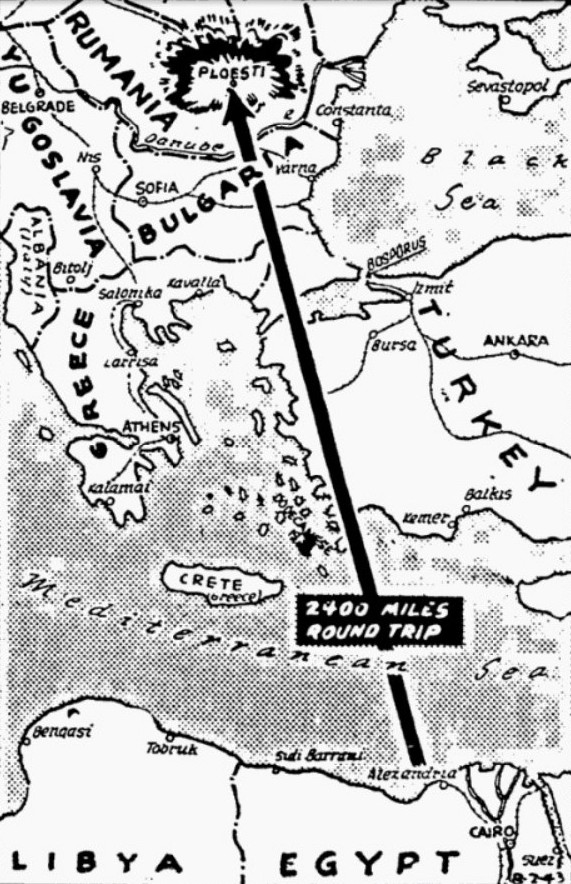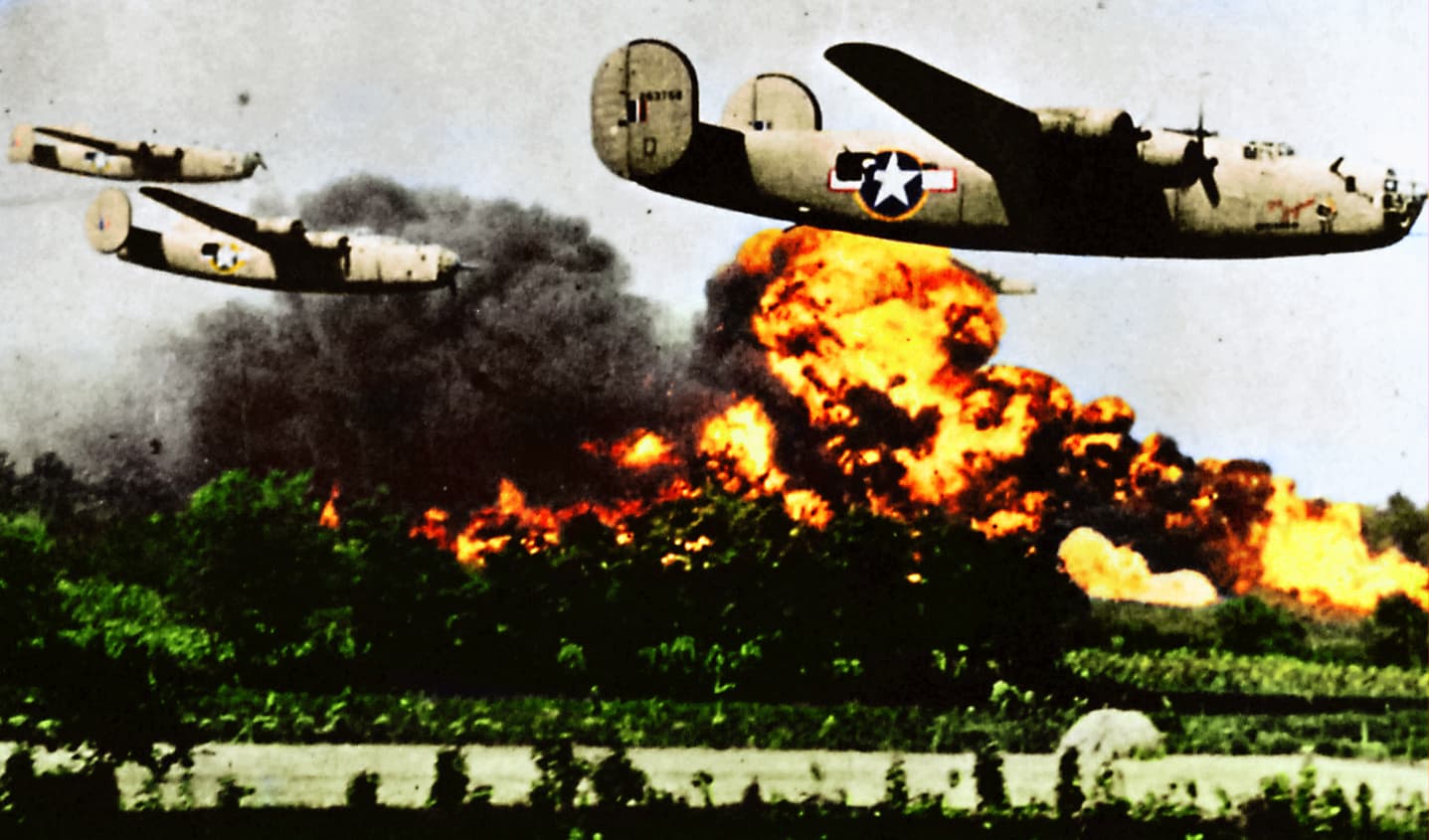The Pittsburgh Press (August 2, 1943)
Yank bombers rip Romania’s key oil fields
Americans leave flaming ruin at Ploești; 20 planes lost
By Leon Kay, United Press staff writer
Giving Hitler an ‘A’ card, U.S. bombers yesterday blasted one of Germany’s main sources of gasoline by blasting the Ploești oil fields of Romania in a 2,400-mile flight.
Cairo, Egypt –
Twenty out of nearly 200 U.S. Liberators that turned Romania’s vast Ploești oil fields into a flaming ruin yesterday were shot down over the target area and an additional unspecified number have failed to return from the record 2,400-mile flight, a communiqué announced today.
Advices from the Balkans said that great fires were still raging today in the oil fields, 24 hours after the raid, and the attack was hailed here as a success, with the results far outweighing the cost.
Hits were reported from heights of 100-500 feet on distillation plants, fractionation towers, boiler houses and storage tanks, which provide oil for one-third to one-half of the German war machine.
See sheets of flames
A Royal Air Force communiqué on the raid said:
Heavy explosions and sheets of flames were observed among oil refinery installations while many fires were started.
At least 51 intercepting German fighters, including Fw 190s and Me 109s and 110s, were shot down by the unescorted Liberators, according to the communiqué, and other reports indicated that the bag might reach 53.
The Liberators also ran into heavy anti-aircraft fire.
Two refineries wrecked
At least two of the 13 oil refineries in the Ploești area were wrecked and the entire district, 35 miles north of Bucharest, was left wreathed in flames and smoke. Col. Leon Johnson, who commanded one group of Liberators, said the scene was the “closest thing to Dante’s Inferno I ever saw.”
Dipping to chimney-stack level, wave after wave of the four-engined bombers swept over the 19-square-mile oil fields shortly after 2 p.m. yesterday, dropping 300 tons of high explosive and firebombs and strafing everything in sight.
Brig. Gen. Uzal G. Ent, chief of the 9th Air Force Bomber Command and leader of the raid, said in an NBC broadcast from Cairo that the raid “contributed materially to hastening the end of the Axis.” Normally, he said, the fields produce 18,000 tons of fuel oil, “but it will be a long time before they turn out that much again.”
The refineries provide 90% of the German Air Force’s gasoline supplies.
The Astro Română refinery, believed to be the largest in Europe, was reported damaged heavily and still burning. The pumping station on the Giurgiu pipeline which conveys oil to the Danube received numerous hits followed by many heavy explosions.
The Creditul refinery, newest in the fields and producer of aviation gas, was reported the site of raging fires. Vital parts of the Steaua Română refinery were hit squarely. The Româno-Americană refinery’s distillation plant was reported “most heavily damaged.”
Cracking tower hit
A refinery at Câmpina, 20 miles from Ploești itself, was destroyed, and direct hits were scored on the cracking tower of another nearer Ploești, effectively halting production there. Smoke and fire hampered full observation of damage to other objectives.
The raid was the fourth by the Allies on the Ploești fields, the Russians having bombed them twice in 1941 and the U.S. 9th Air Force having followed through with a raid from Palestinian bases a little more than a year ago.
Trains 2,000 fliers
This time, the Allied High Command decided to attempt to destroy the Ploești refineries and other installations with one massive blow and Maj. Gen. Lewis H. Brereton, U.S. Middle East commander, took over the task of training 2,000 American crewmen.
The big Liberators roared out from their Middle Eastern bases early yesterday and swept across the Mediterranean and Aegean Seas and Bulgaria into Romania, barely skimming the treetops at times. Churchgoing crowds waved to them.
Over Ploești, the airmen rained bombs on their targets and within a matter of minutes the oil fields were a mass of flames. The fliers used special low-level bombsights. Many of the bombs dropped had delayed action fuses.
Soot covers plane
Maj. Norman Appold of Detroit, who piloted one of the last planes over the target, said a tremendous explosion in the middle of the oil fields covered his Liberator with smoke and soot.
1st Lt. Frank D. Slough of Woodland Hill, California, who once raided Kiel from a base in Britain, said the raid was “far rougher” than those he had seen on Germany. Anti-aircraft fire riddled several fires.
Col. John R. “Killer” Kane, another veteran raider, said the whole refineries area appeared on fire. His group shot down at least 33 enemy fighters.
Sgt. Jack Swafford, waist gunner on a plane known as Little Joe, said he saw one oil tank “open up like a coffee pot,” sending flames high in the air.
Send oil ‘by air’
Enough bombs were dropped to “send all the oil in Romania to Berlin by air,” commented 2nd Lt. Arthur A. Johnson of Fort Dodge, Iowa.
Another pilot told of seeing three to four fires burning in one refinery and flames shooting 500 feet in the air from storage tanks.
Capt. Harold A. Wicklund, who took part in the raid on Rome, said he “enjoyed this one much more.”
He said:
I saw lots of smoke. We did some damage. It all happened so fast I don’t know for sure what we hit.
Corn sticks to plane
Sgt. Harry Schultz of Kansas City, Missouri, said the fires in the Ploești fields were the largest he had seen in any raid.
Flying Officer Raymond J. Lacombe of Providence, Rhode Island, said his plane swept so low that it returned to its base with corn on the bottom.
The bomb bay doors failed to open on a Liberator piloted by Lt. John Blackis of New Kensington, Pennsylvania, and Sgt. Joseph Landry of Manchester, New Hampshire, the engineer, climbed down from the top turret and cranked them open by hand. Replacing him in the turret, Sgt. David L. Rosenthal of Newark, New Jersey, the radio operator, brought down a Me 109 with the first 50 rounds he had ever fired from a machine gun.
Lt. Blackis, 22, is the son of Thomas Blackis, 1250 Taylor Ave., New Kensington. A former Carnegie Institute of Technology student, he began flying five years ago while still in high school.
Brereton greets fliers
Gen. Brereton was on hand at the signal tower waiting for the Liberators to return to their bases. The first to come in was the Doodlebug, piloted by 1st Lt. John E. McAtee of San Francisco.
Gen. Ent was in the sixth plane to land and Gen. Brereton shook hands with him as he emerged.


